2023 SUBARU BRZ ESP
[x] Cancel search: ESPPage 303 of 432
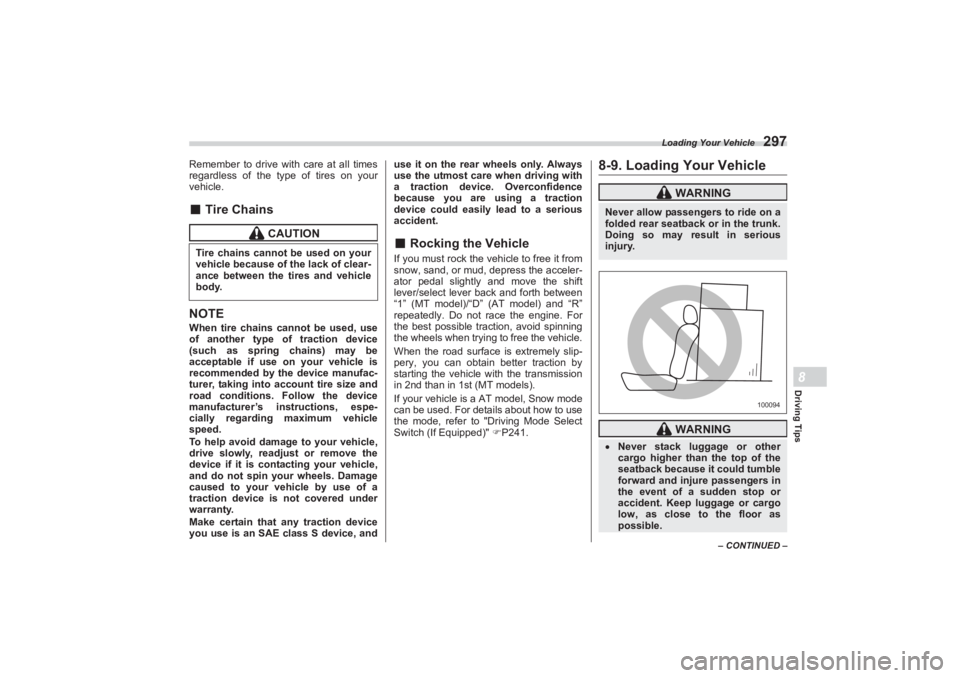
Loading Your Vehicle
297
Driving Tips8
– CONTINUED –
Remember to drive with care at all times
regardless of the type of tires on your
vehicle.■ Tire Chains
NOTEWhen tire chains cannot be used, use
of another type of traction device
(such as spring chains) may be
acceptable if use on your vehicle is
recommended by the device manufac-
turer, taking into account tire size and
road conditions. Follow the device
manufacturer’s instructions, espe-
cially regarding maximum vehicle
speed.
To help avoid damage to your vehicle,
drive slowly, readjust or remove the
device if it is contacting your vehicle,
and do not spin your wheels. Damage
caused to your vehicle by use of a
traction device is not covered under
warranty.
Make certain that any traction device
you use is an SAE class S device, and use it on the rear wheels only. Always
use the utmost care when driving with
a traction device. Overconfidence
because you are using a traction
device could easily lead to a serious
accident.
■ Rocking the VehicleIf you must rock the v ehicle to free it from
snow, sand, or mud, depress the acceler-
ator pedal slightly and move the shift
lever/select lever back and forth between
“1” (MT model)/“D” (AT model) and “R”
repeatedly. Do not race the engine. For
the best possible traction, avoid spinning
the wheels when trying to free the vehicle.
When the road surface is extremely slip-
pery, you can obtain better traction by
starting the vehicle with the transmission
in 2nd than in 1st (MT models).
If your vehicle is a AT model, Snow mode
can be used. For details about how to use
the mode, refer to "Driving Mode Select
Switch (If Equipped)" P241.
8-9. Loading Your Vehicle
CAUTION
Tire chains cannot be used on your
vehicle because of the lack of clear-
ance between the tires and vehicle
body.
WARNING
Never allow passengers to ride on a
folded rear seatback or in the trunk.
Doing so may result in serious
injury.
WARNING
Never stack luggage or other
cargo higher than the top of the
seatback because it could tumble
forward and injure passengers in
the event of a sudden stop or
accident. Keep luggage or cargo
low, as close to the floor as
possible.
100094
BRZ_U.book 297 ページ 2022年3月29日 火曜日 午後3時59分
Page 305 of 432
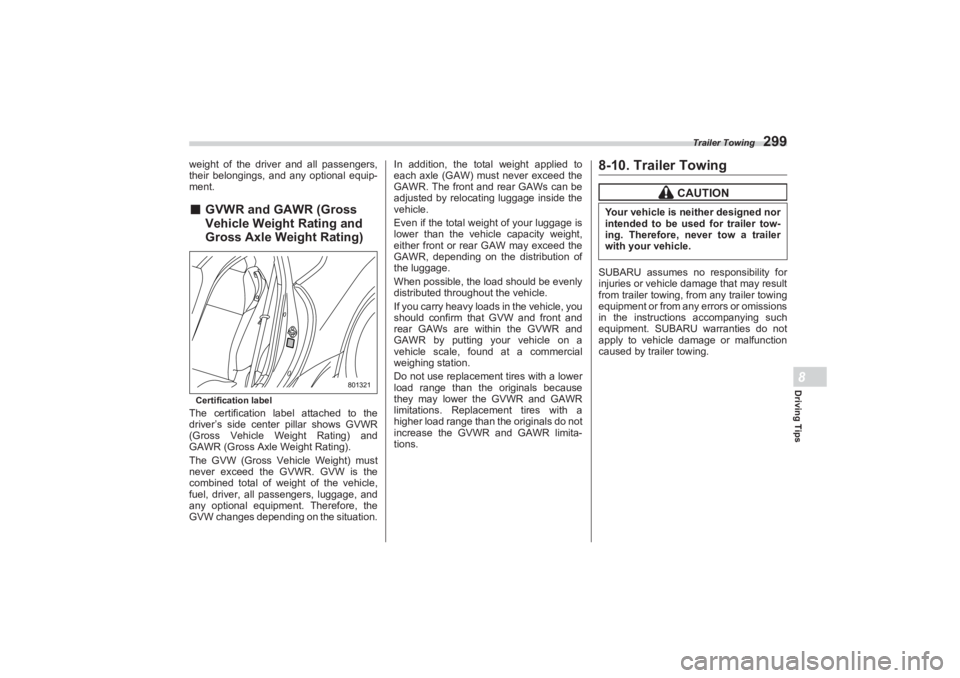
Trailer Towing
299
Driving Tips8
weight of the driver and all passengers,
their belongings, and any optional equip-
ment.■ GVWR and GAWR (Gross
Veh icle Weight Rating an d
Gross Axle Weight Rating)Certification labelThe certification label attached to the
driver’s side center pillar shows GVWR
(Gross Vehicle Weight Rating) and
GAWR (Gross Axle Weight Rating).
The GVW (Gross Vehicle Weight) must
never exceed the GVWR. GVW is the
combined total of weight of the vehicle,
fuel, driver, all passengers, luggage, and
any optional equipment. Therefore, the
GVW changes depending on the situation. In addition, the tota
l weight applied to
each axle (GAW) must never exceed the
GAWR. The front and rear GAWs can be
adjusted by relocating luggage inside the
vehicle.
Even if the total weight of your luggage is
lower than the vehicl e capacity weight,
either front or rear GAW may exceed the
GAWR, depending on the distribution of
the luggage.
When possible, the load should be evenly
distributed throughout the vehicle.
If you carry heavy loads in the vehicle, you
should confirm that GVW and front and
rear GAWs are within the GVWR and
GAWR by putting your vehicle on a
vehicle scale, found at a commercial
weighing station.
Do not use replacement tires with a lower
load range than the originals because
they may lower the GVWR and GAWR
limitations. Replacement tires with a
higher load range than the originals do not
increase the GVWR and GAWR limita-
tions.
8-10. Trailer TowingSUBARU assumes no responsibility for
injuries or vehicle damage that may result
from trailer towing, from any trailer towing
equipment or from any errors or omissions
in the instructions accompanying such
equipment. SUBARU warranties do not
apply to vehicle damage or malfunction
caused by trailer towing.
801321
CAUTION
Your vehicle is neither designed nor
intended to be used for trailer tow-
ing. Therefore, never tow a trailer
with your vehicle.
BRZ_U.book 299 ページ 2022年3月29日 火曜日 午後3時59分
Page 308 of 432
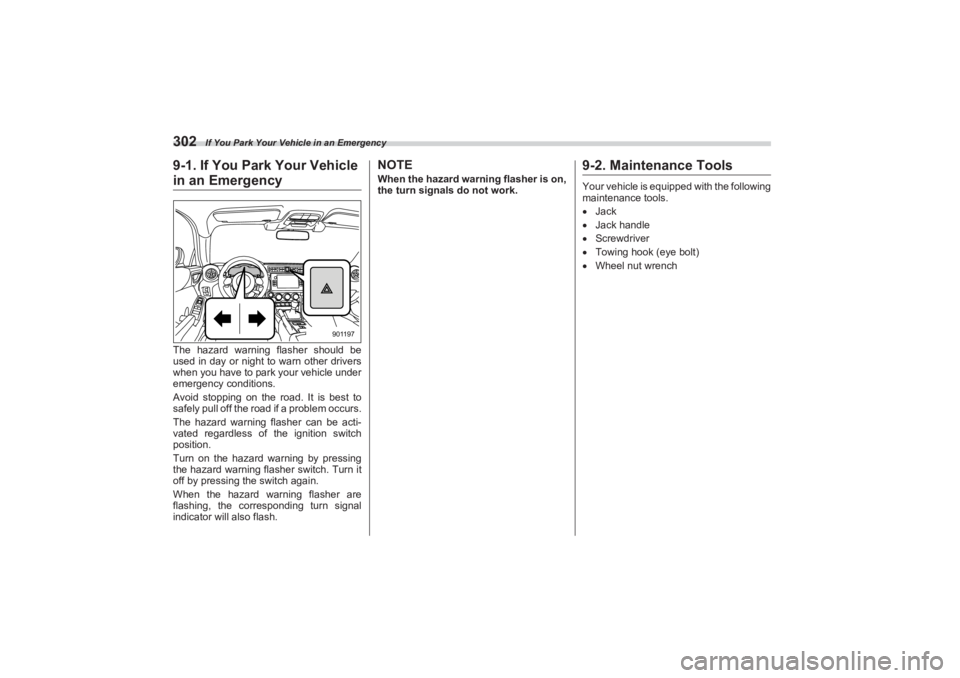
If You Park Your Vehicle in an Emergency
3029-1. If You Park Your Vehicle in an EmergencyThe hazard warning flasher should be
used in day or night to warn other drivers
when you have to park your vehicle under
emergency conditions.
Avoid stopping on the road. It is best to
safely pull off the road if a problem occurs.
The hazard warning flasher can be acti-
vated regardless of the ignition switch
position.
Turn on the hazard warning by pressing
the hazard warning flasher switch. Turn it
off by pressing the switch again.
When the hazard warning flasher are
flashing, the corresponding turn signal
indicator will also flash.
NOTEWhen the hazard warning flasher is on,
the turn signals do not work.
9-2. Maintenance ToolsYour vehicle is equipped with the following
maintenance tools.
Jack
Jack handle
Screwdriver
Towing hook (eye bolt)
Wheel nut wrench
901197
BRZ_U.book 302 ページ 2022年3月29日 火曜日 午後3時59分
Page 340 of 432
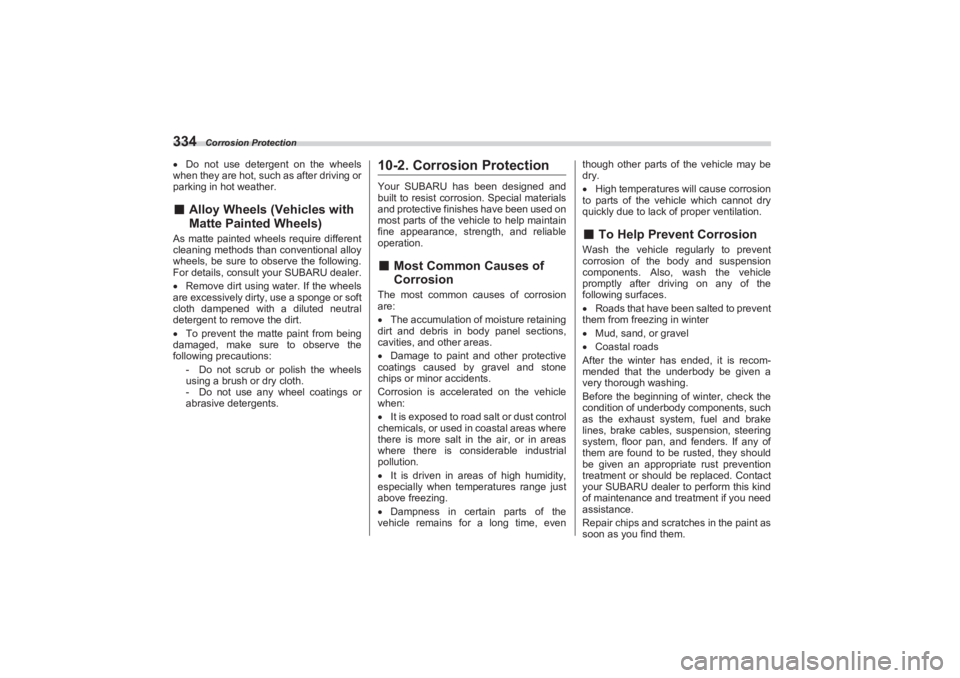
Corrosion Protection
334Do not use detergent on the wheels
when they are hot, such as after driving or
parking in hot weather.■ Alloy Wheels (Vehicles with
Matte Painted Wheels)As matte painted wheels require different
cleaning methods than conventional alloy
wheels, be sure to observe the following.
For details, consult your SUBARU dealer.
Remove dirt using water. If the wheels
are excessively dirty, use a sponge or soft
cloth dampened with a diluted neutral
detergent to remove the dirt.
To prevent the matte paint from being
damaged, make sure to observe the
following precautions:
- Do not scrub or polish the wheels
using a brush or dry cloth.
- Do not use any wheel coatings or
abrasive detergents.
10-2. Corrosion ProtectionYour SUBARU has been designed and
built to resist corrosi on. Special materials
and protective finishes have been used on
most parts of the vehicle to help maintain
fine appearance, strength, and reliable
operation.■ Most Common Causes of
CorrosionThe most common causes of corrosion
are:
The accumulation of moisture retaining
dirt and debris in body panel sections,
cavities, and other areas.
Damage to paint and other protective
coatings caused by gravel and stone
chips or minor accidents.
Corrosion is accelera ted on the vehicle
when:
It is exposed to road salt or dust control
chemicals, or used in coastal areas where
there is more salt in the air, or in areas
where there is considerable industrial
pollution.
It is driven in areas of high humidity,
especially when temperatures range just
above freezing.
Dampness in certain parts of the
vehicle remains for a long time, even though other parts of the vehicle may be
dry.
High temperatures will cause corrosion
to parts of the vehicle which cannot dry
quickly due to lack of proper ventilation.
■ To Help Prevent CorrosionWash the vehicle regularly to prevent
corrosion of the body and suspension
components. Also, wash the vehicle
promptly after driving on any of the
following surfaces.
Roads that have been salted to prevent
them from freezing in winter
Mud, sand, or gravel
Coastal roads
After the winter has ended, it is recom-
mended that the underbody be given a
very thorough washing.
Before the beginning of winter, check the
condition of underbody components, such
as the exhaust system, fuel and brake
lines, brake cables, suspension, steering
system, floor pan, and fenders. If any of
them are found to be rusted, they should
be given an appropriate rust prevention
treatment or should be replaced. Contact
your SUBARU dealer to perform this kind
of maintenance and treatment if you need
assistance.
Repair chips and scratches in the paint as
soon as you find them.
BRZ_U.book 334 ページ 2022年3月29日 火曜日 午後3時59分
Page 362 of 432
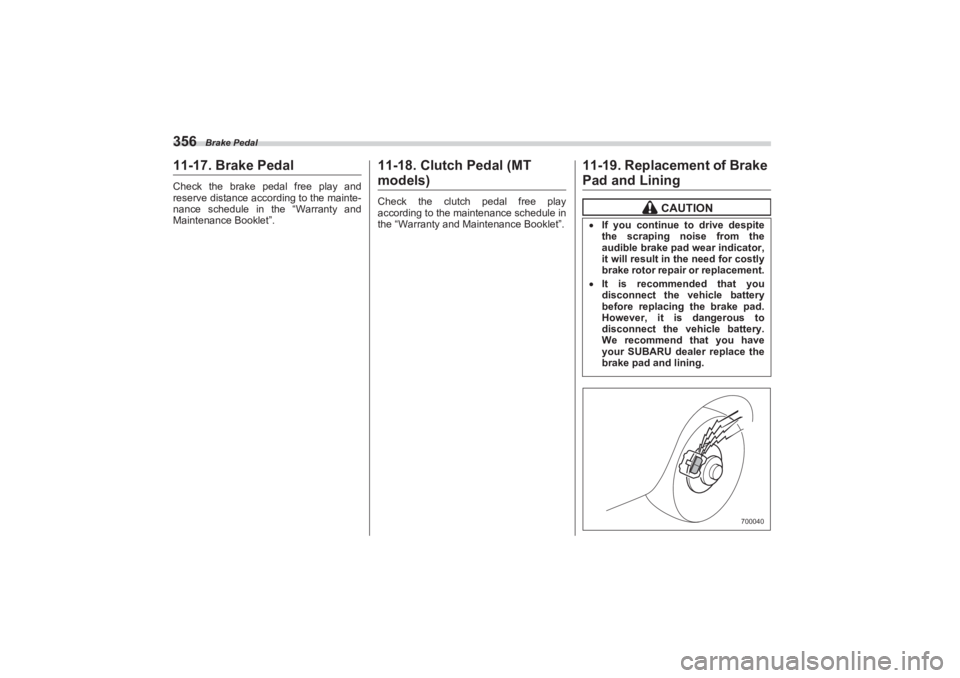
Brake Pedal
35611-17. Brake PedalCheck the brake pedal free play and
reserve distance according to the mainte-
nance schedule in the “Warranty and
Maintenance Booklet”.
11-18. Clutch Pedal (MTmodels)Check the clutch pedal free play
according to the maintenance schedule in
the “Warranty and Maintenance Booklet”.
11-19. Replacement of BrakePad and Lining
CAUTION
If you continue to drive despite
the scraping noise from the
audible brake pad wear indicator,
it will result in the need for costly
brake rotor repair or replacement. It is recommended that you
disconnect the vehicle battery
before replacing the brake pad.
However, it is dangerous to
disconnect the vehicle battery.
We recommend that you have
your SUBARU dealer replace the
brake pad and lining.
700040
BRZ_U.book 356 ページ 2022年3月29日 火曜日 午後3時59分
Page 368 of 432
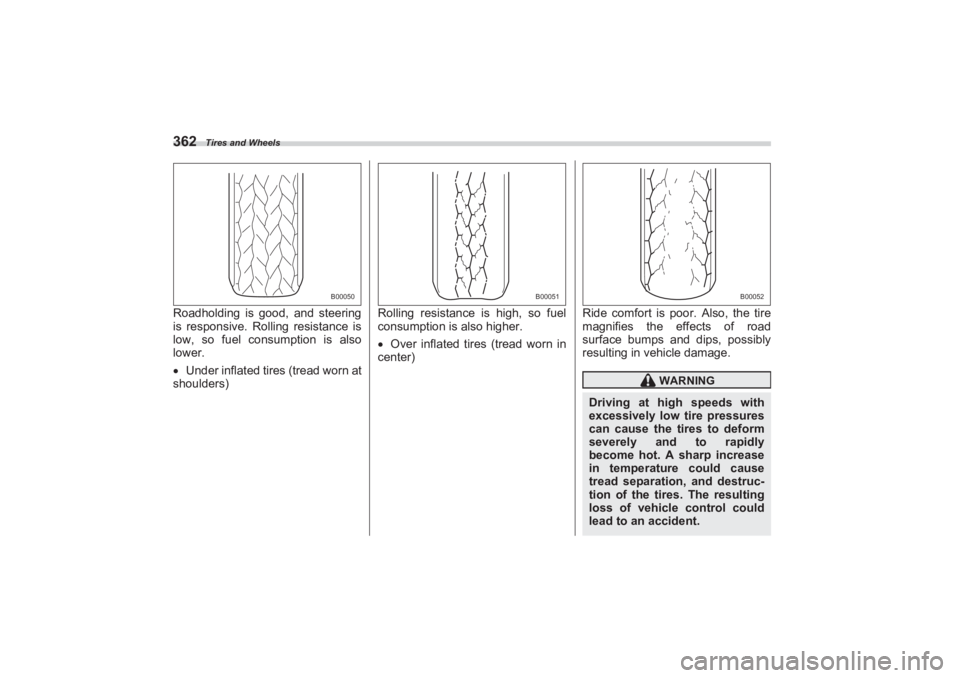
Tires and Wheels
362Roadholding is good, and steering
is responsive. Rolling resistance is
low, so fuel consumption is also
lower.
Under inflated tires (tread worn at
shoulders) Rolling resistance is high, so fuel
consumption is also higher.
Over inflated tires (tread worn in
center) Ride comfort is poor. Also, the tire
magnifies the effects of road
surface bumps and dips, possibly
resulting in vehicle damage.
B00050
B00051
WARNING
Driving at high speeds with
excessively low tire pressures
can cause the tires to deform
severely and to rapidly
become hot. A sharp increase
in temperature could cause
tread separation, and destruc-
tion of the tires. The resulting
loss of vehicle control could
lead to an accident.
B00052
BRZ_U.book 362 ページ 2022年3月29日 火曜日 午後3時59分
Page 378 of 432

Fuses
3721) Fuse pullerThe other one (main fuse box) is housed
in the engine compartment. Also, the fuse
puller are stored in the fuse box.
Pinch the upper part of the fuse puller
when removing it from the main fuse box.
1) Good
2) BlownIf any lights, accessories or other elec-
trical controls do not operate, inspect the
corresponding fuse. If a fuse has blown,
replace it.
1. Turn the ignition switch to the “OFF”
position and turn off all electrical accesso-
ries.
2. Remove the fuse box cover.
3. Determine which fuse may be blown.
Look at the back side of each fuse box
cover. 4. Pull out the fuse with the fuse puller.
5. Inspect the fuse. If it has blown,
replace it with a spare fuse of the same
rating.
6. If the same fuse blows again, this indi-
cates that its system has a problem.
Contact your SUBARU dealer for repairs.
1B02118
B01008
12
B00975
BRZ_U.book 372 ページ 2022年3月29日 火曜日 午後3時59分
Page 404 of 432

Tire Information
398Cord separation
The parting of cords from adjacent
rubber compounds.
Cracking
Any parting within the tread,
sidewall, or inner liner of the tire
extending to cord material.
Curb weight
The weight of a motor vehicle with
standard equipment including the
maximum capacity of fuel, oil and
coolant, and if so equipped, air
conditioning and additional weight
optional engine.
Extra load tire
A tire designed to operate at higher
loads and higher inflation pressure
than the corresponding standard
tire.
Groove
The space between two adjacent
tread ribs.
Innerliner
The layer(s) forming the inside
surface of a tubeless tire that contains the inflating medium within
the tire.
Innerliner separation
The parting of the innerliner from
cord material in the carcass.
Intended outboard sidewall
(1) The sidewall that contains a
whitewall, bears white lettering or
bears manufacturer, brand, and/
or model name molding that is
higher or deeper than the same
molding on the other sidewall of
the tire, or
(2) The outward facing sidewall
of an asymmetrical tire that has a
particular side that must always
face outward when mounting on a
vehicle.
Light truck (LT) tire
A tire designated by its manufac-
turer as primarily intended for use
on lightweight trucks or multipur-
pose passenger vehicles.
Load rating
The maximum load that a tire is
rated to carry for a given inflation
pressure.
Maximum inflation pressure
The maximum cold inflation pres-
sure to which a tire may be inflated.
Maximum load rating
The load rating for a tire at the
maximum permissible inflation pres-
sure for that tire.
Maximum loaded vehicle
weight
The sum of:
(a) Curb weight
(b) Accessory weight
(c) Vehicle capacity weight
(d) Production options weight
Maximum permissible inflation
pressure
The maximum cold inflation pres-
sure to which a tire may be inflated.
Measuring rim
The rim on which a tire is fitted for
physical dimension requirements.
Normal occupant weight
150 lbs (68 kg) times the number of
occupants specified in the second
column of Table 1 that is appended
to the end of this section.BRZ_U.book 398 ページ 2022年3月29日 火曜日 午後3時59分